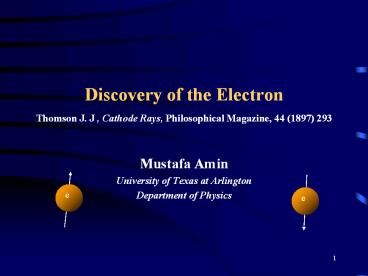Discovery%20of%20the%20Electron - PowerPoint PPT Presentation
Title:
Discovery%20of%20the%20Electron
Description:
Mica Cross experiment by Sir William Crookes (1897) Cathode ... slits in the cylinders, the electrometer measures the charge transferred to the cylinder.[1] ... – PowerPoint PPT presentation
Number of Views:75
Avg rating:3.0/5.0
Title: Discovery%20of%20the%20Electron
1
Discovery of the Electron
Thomson J. J , Cathode Rays, Philosophical
Magazine, 44 (1897) 293
- Mustafa Amin
- University of Texas at Arlington
- Department of Physics
e
e
2
Outline
- Introduction
- Historical Background
- Thompsons Experiment
- Millikans Experiment
- Conclusion
e
e
3
Introduction
- The Atom is no longer indivisible!!!
- Electron, the first fundamental particle
- Birth of Elementary Particle Physics
e
e
4
Background
- Electric Discharge green phosphoroscence
- Something travels in straight lines
- Mica Cross experiment by Sir William Crookes
- (1897) Cathode Rays Aetherial or Material ?
- Material Deflection by magnet
- Negative charge (Perrin)
- Deflection by a static electric
field? - Aetherial Penetration of thin metal sheets
(Hertz)
5
Thompsons Experiment
- Charge carried by the Cathode Rays
- Electrostatic Deflection of Cathode rays
- Determination of e/m
e
6
Charge carried by cathode rays
Cathode rays pass from the tube in the upper left
into the larger bulb, where they are deflected
with a magnetic field. When they are bent so as
to enter the slits in the cylinders, the
electrometer measures the charge transferred to
the cylinder.1
Thomson J. J , Cathode Rays, Philosophical
Magazine, 44 (1897) 293
7
Deflexion of Cathode rays by Electrostatic Field
and Velocity
Thomson J. J , Cathode Rays, Philosophical
Magazine, 44 (1897) 293
- C Cathode
- A, B Anode and Ground
- D, E Capacitor plates
- Velocity
- qvB qE or v E/B
- v c / 3 1000 times the velocity of Hydrogen !!
8
Determination of e/m
- Displacement
- 2s a t2
- ( Ee/m )( l2/v2 )
- Charge to mass ratio
- e/m (2s/E)( v2/l2 )
- 17000000 (c.g.s units)
- 17000 times the e/mH for Hydrogen
9
Magnitude of e
- e/m 17000 times the e/mH for Hydrogen
- e large ?
- m small?
- Wilsons Experiment
- Townsends Experiment
- Millikans Experiment
- Conclusion Small m !!!!
e
10
Millikans Experiment
With E m g q E Without E
m g K vT ,
K 6p h r q n (1.6 10-7 C)
Quantized charge !!!!
http//www.kingsu.ab.ca/brian/templeton
11
Conclusion
Charge e 1.6 10-19 C Mass m 9.1
10-31 kg Spin s 1/2, -1/2 (Uhlenbeck,
Goudsmith)
12
"Could anything at first sight seem more
impractical than a body which is so small that
its mass is an insignificant fraction of the mass
of an atom of hydrogen?"-- J.J. Thomson.































